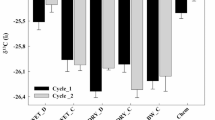Abstract
This research aimed at evaluating the quality of anaerobic compost from solid substrate anaerobic digesters for potential use as a soil amender. A factorial experiment 4 × 2 × 2 was run. The factors were feedstock type, temperature in reactors (35 and 55 °C) and mass retention time (MRT, 16 and 23 days). The feedstocks used consisted of four mixtures of food waste (FW) and lignocellulosic fraction (LG): 100% FW, 67% FW-33% LG, 33% FW-67% LG and 100% LG which were designated as FS1, FS2, FS3 and FS4, respectively. The anaerobic compost coming from feedstocks with increasing proportion of lignocellulosic fraction (FS3 and FS4) were of higher quality and gave the lowest chemical oxygen demand, biochemical oxygen demand, volatile organic acids and total ammonia nitrogen concentrations in the extract and the highest germination indices. Heavy metal concentrations in all the anaerobic composts were lower than the maximum levels indicated in USA and European compost quality standards. However, high total oxygen uptake, moderate to high concentrations of volatile organic acids and ammonia, and germination indices under 60% indicated that the anaerobic compost was not suitable for direct use as a soil improver.
Access this chapter
Tax calculation will be finalised at checkout
Purchases are for personal use only
Preview
Unable to display preview. Download preview PDF.
Similar content being viewed by others
References
Alexander M (1977) Introduction to soil microbiology. 2“d edn. John Wiley, New York
Chaney RL, Ryan JA (1993) Heavy metals and toxic organic pollutants in municipal solid wastes composts. In: Hoitink HAM, Keener HM (eds) Science and engineering of composting: design, environmental, microbiological and utilization aspects. Renaissance Publishers, Worthington, OH, pp 451–489
Gómez-Cisneros E. (1997) Aerobic post-composting of anaerobic compost from DASS process. MS Thesis, CINVESTAV Dept of Biotechnology, Mexico DF, México.
Iglesias E, Pérez V (1989) Evaluation of city refuse compost maturity: a review. Biol Wastes 27 (2): 115–142
Kapetanios E, Loizidou M, Valkanas G (1993) Compost production from Greek domestic refuse. Bioresour Technol 44 (1): 13–16
Lozano-Vinalay N, Poggi-Varaldo HM (1995) Germination bioassay with seeds (Raphanus sativus) for the evaluation of waste biological treatment. 1st Int. Meet. on Microbial Ecology, México DF, México p. 43
Mathur S, Owen G, Dinel H, Schniter M (1993) Determination of compost biomaturity. I. Literature review. Biol Agric Hortic 10 (1): 65–85
Michel FC Jr, Reddy AC, Forney LE (1995) Microbial degradation and humification of the lawn care pesticide 2,4-dichlorophenoxyacetic acid during the composting of yard trimmings. Appl Environ Microbiol 61 (7): 2566–2571
Montgomery DC (1991) Design and analysis of experiments. John Wiley; New York
Poggi-Varaldo HM (1999) Interim report to CONACYT. Research project solid substrate anaerobic digestion of municipal and industrial solid wastes. DBB-CINVESTAV, Environ. Biotechnol. RandD Group, México DF, México
Poggi-Varaldo HM, Oleszkiewicz J (1992) Anaerobic co-composting of municipal solid waste and waste sludge at high total solids levels. Environ Technol 13 (3): 409–421
Poggi-Varaldo HM, Rinderknecht-Seijas N (1990) Mini-handbook of solid waste analysis, CINVESTAV del IPN, México DF, México (in English) available upon request
Poggi-Varaldo HM, Valdéz-Ledezma L (1995) Optimization of dry anaerobic digestion start-up, Proc. 17th Canadian Waste Management Conference, Sept 11–14, Quebec City, QC, Canada. Proceedings on diskette
Poggi-Varaldo HM, Yu A, Rinderknecht N (1995) Dry anaerobic digestion: a review and feasibility study, R’95 Recovery, Recycling, Re-integration, Febr 1–4, Geneve, Switzerland
Poggi-Varaldo HM, Valdés L, Esparza-Garcia F, Fernandez-Villagómez G. (1997) Solid substrate anaerobic co-digestion of paper mill sludge, biosolids and municipal solid wastes. Water Sci Technol 35 (23): 197–204
Poggi-Varaldo HM, Rodriguez-Vazquez R, Fernandez-Villagómez G, Esparza-Garcia F (1997) Inhibition of mesophilic solid-substrate anaerobic digestion by ammonia nitrogen. Appl Microbiol Biotechnol 47 (3): 284–291
Sparling RS, Risbey D, Poggi-Varaldo HM (1997) Hydrogen production from inhibited anaerobic composters. J Hydrogen Energy 22 (6): 563–566
Trejo-Espino JL (1999) Determination of anaerobic compost quality and its post-treatment with ligninolytic fungi. MS Thesis. CINVESTAV del IPN, Dept of Biotechnology. México DF, México (in Spanish)
Valdés-Ledezma L (1997) Start-up of DASS reactors and the feasibility of the process for the co-digestion of municipal and industrial solid waste. MS Thesis, CINVESTAV del IPN, Dept of Biotechnology. México DF, México (in Spanish)
Villar MC, Beloso MC, Acea MJ, Cabaneiro A, Gonzalez-Prieto SJ, Carballas M, Diaz-Ravina M, Carballas T (1993) Physical and chemical characterization of four composted urban residues. Bioresour Technol 45 (1): 105–113
Zucconi F, Forte M, Monaco A, De Bertoldi M (1981) Biological evaluation of compost maturity. BioCycle 22 (4): 27–35
Author information
Authors and Affiliations
Editor information
Editors and Affiliations
Rights and permissions
Copyright information
© 2002 Springer-Verlag Berlin Heidelberg
About this paper
Cite this paper
Poggi-Varaldo, H.M., Gómez-Cisneros, E., Rodríguez-Vázquez, R., Trejo-Espino, J., Rinderknecht-Seijas, N. (2002). Unsuitability of Anaerobic Compost from Solid Substrate Anaerobic Digestion as Soil Amendment. In: Insam, H., Riddech, N., Klammer, S. (eds) Microbiology of Composting. Springer, Berlin, Heidelberg. https://doi.org/10.1007/978-3-662-08724-4_13
Download citation
DOI: https://doi.org/10.1007/978-3-662-08724-4_13
Publisher Name: Springer, Berlin, Heidelberg
Print ISBN: 978-3-642-08705-9
Online ISBN: 978-3-662-08724-4
eBook Packages: Springer Book Archive




